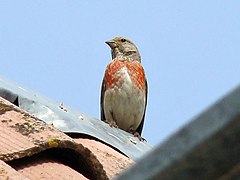Common linnet: Difference between revisions
m Reverted edits by 129.2.218.128 (talk) to last version by Kmoksy |
No edit summary |
||
| Line 83: | Line 83: | ||
==External links== |
==External links== |
||
*[http://www.acopiancenter.am/boa.asp?id=332 A Field Guide to Birds of Armenia: Eurasian Linnet] |
|||
* [http://www.bsc-eoc.org/avibase/species.jsp?lang=EN&id=3D124E32B595A8EC&ts=1221559455166&sec=summary Avibase] |
* [http://www.bsc-eoc.org/avibase/species.jsp?lang=EN&id=3D124E32B595A8EC&ts=1221559455166&sec=summary Avibase] |
||
* [http://www.arkive.org/species/ARK/birds/Carduelis_cannabina/ ARChive] Videos, stills |
* [http://www.arkive.org/species/ARK/birds/Carduelis_cannabina/ ARChive] Videos, stills |
||
Revision as of 19:00, 25 November 2010
- For the North American bird, see House Finch
| Linnet | |
|---|---|

| |
| male | |
| Scientific classification | |
| Kingdom: | |
| Phylum: | |
| Class: | |
| Order: | |
| Family: | |
| Genus: | |
| Species: | C. cannabina
|
| Binomial name | |
| Carduelis cannabina (Linnaeus, 1758)
| |
The Linnet, Carduelis cannabina, is a small passerine bird in the finch family Fringillidae.
The Linnet derives its scientific name from its fondness for hemp and its English name from its liking for seeds of flax, from which linen is made.
Description
It is a slim bird with a long tail. The upperparts are brown, the throat is sullied white and the bill is grey. The summer male has a grey nape, red head patch and red breast.
Females and young birds lack the red and have white underparts with the breast streaked buff. The Linnet's pleasant song contains fast trills and twitters.
Distribution
This bird breeds in Europe, western Asia and north Africa. It is partially resident, but many eastern and northern birds migrate further south in the breeding range or move to the coasts.
They are sometimes found several hundred miles at sea[1].
Behaviour
Open land with thick bushes is favoured for breeding, including heathland and garden. It builds its nest in a bush, laying 4-7 eggs.
This species can form large flocks outside the breeding season, sometimes mixed with other finches, such as Twite, on coasts and salt marshes. Its food mainly consists of seeds, which it also feeds to its chicks.
They feed on the ground, and low down in bushes.
They like small to medium sized seeds: most arable weeds, Polygonums (Knotgrass, dock), Crucifers (Charlock, shepherds purse Capsella bursa-pastoris), Chickweeds Stellaria, Dandelions, Thistle, Sow-thistle, Mayweed, Common groundsel, Common Hawthorn, Birch.
They have a small component of Invertebrates in their diet.
Conservation
The Linnet is IUCN Redlisted as threatened and also listed by the UK Biodiversity Action Plan as a priority species, which can be found here.It is protected in the UK by the Wildlife and Countryside Act 1981.
In Britain, populations are declining, attributed to increasing use of herbicides, aggressive scrub removal and excessive hedge trimming; its population fell by 56% between 1968 to 1991. This was probably due to decrease in seed supply and increasing use of herbicide being two of the factors.
Favourable management practices on agricultural land:
- Set-aside
- Overwinter Stubbles
- Uncultivated margins, ditches, field corners
- Conservation headlands
- Wild bird cover of species that produce small, oil-rich seeds such as Kale, Quinoa, Mustard plant, Oil-seed rape Brassica napus
- Restoration and creation of hay meadows
- Short, thick, thorny hedgerows and scrub for nesting habitat
- Restoration of meadows
Cultural references
The bird was a popular pet in late Victorian and Edwardian times. Tennyson mentions "the linnet born within the cage" in part 27 of the poem In Memoriam A.H.H, the same section that contains the famous lines "'Tis better to have loved and lost / Than never to have loved at all." A "cock linnet" features in the classic British music hall song of that period My Old Man, and as a character in Oscar Wilde's children's story The Devoted Friend. Wilde also mentions how the call of the linnet awakens The Selfish Giant to the one tree where it is springtime in his garden.
"The Linnets" has become the nickname of King's Lynn Football Club, Burscough Football Club and Runcorn Linnets Football Club (formerly known as 'Runcorn F.C.' and Runcorn F.C. Halton). Barry Town F.C., the South Wales-based football team, also used to be nicknamed 'The Linnets'.
Gallery
-
Carduelis cannabina
-
Young in nest
References
- Template:IUCN2006 Database entry includes justification for why this species is of least concern
- Ageing and sexing (PDF) by Javier Blasco-Zumeta
- RSPB A management guide to birds of lowland farmland
External links
- A Field Guide to Birds of Armenia: Eurasian Linnet
- Avibase
- ARChive Videos, stills
- BBC Wildlifefinder BBC videos, sound files and information programmes featuring Linnets







